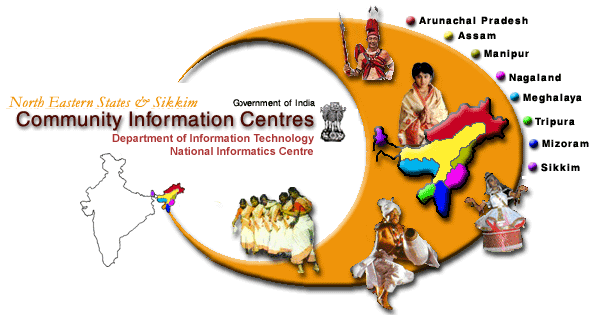|
Community Information Centres in the North-Eastern States of India |
||
| |
||
 Information on community information centres*cicwak After successful implementation of the pilot project, it was decided to cover all 487 blocks of the North Eastern states. Based on the experience gained from the pilot project, action plan was formulated for 457 blocks. The present status of the main phase of the project is as follows: Delivery and installation of computers, peripherals and VSAT's is in progress at the CIC sites. Over 400 sites are ready for commissioning. Both the network hubs have been installed at NIC Headquarters. A major part of the manpower for CIC operation has been recruited. CIC operators in all states have been trained on networking equipment and software applications available at their sites. Establishment of CICs will bridge the digital divide between the North East and the rest of the country. The IT infrastructure set up at the CICs will assist the concerned state governments to provide IT based citizen-centric applications making government services available through the CICs. Local language interfaces will also be provided for the G2C (Government to Citizen) services, wherever necessary. Some of the G2C services, which are proposed to be disseminated from the centers, are: Opportunities in Education Institutions in North Eastern States & outside - Education Portal Service Facilitation Center Vehicle Registration System Rural Bazaar Prices of Agricultural Products on Web Employment Opportunities in the State - Job Portal Web enabled appointment schedule for various medical facilities School Board Results Newspaper headlines Gramodaya database to be created Block projects information system Web enabled electricity bill payment system Cause list for the courts. Arms License Issuance System Issue of Certificates to Handicapped persons Issue of Rural Area certificates Issue of Caste certificates Issue of Certificate of Residence Issue of Death & Birth Certificate Financial Assistance Schemes of the State Government Issue of Licenses to Cinema Halls, Video Parlours & Guest houses Issue of Character Verification for New Recruitment Issue of Succession Certificate for Legal Heirs Web based Information Dissemination System for the Public File Movement System for all the Branches of DC Office |
||
| |
||
 Information on community information centres of sikkim*cicwak Information technology is the modern addition to infrastructure.It is a powerful tool that enhances connectivity and productivity.In view of the geographical isolation of sikkim,the importance of information technology tools increases manifold.For example the internet can be used to advertise sikkim's products and services.It can also act as a major information resources.Computerisation of various departments will streamline thier functioning.Record keeping will become much more efficient and also will retrieving of data.In a nutshell information technology connects us to the rest of the world and at the same time increases our working efficiency tremendously. The government came out with a comphrensive information technology policy with the objective of giving a fillip to a planned introduction of the tool in the state as such various projects are undregoing for the same as such to step into the world's information super highway. Though small, the mountain state of Sikkim occupies an important niche of its own, in the Indian Union. The grandeur of its mountain peaks, lush valleys, fast flowing rivers, terraced hills and incredible floral wealth, make a visit to Sikkim a truly unique and unforgettable experience. Situated on the eastern Himalayas, in the shadow of the towering Mount Kanchenjunga, which is worshipped as the principal deity, Sikkim measures approximately 100 kms from north to south and 60 kms from east to west. Surrounded by Tibet, Nepal and Bhutan on three sides and with West Bengal on the fourth, Sikkim is a strategically significant state. It is entirely mountainous, with one - third of the land covered with dense forests of sal, sambal and bamboo, which are mostly inaccessible and unexploited. Sikkim receives heavy rainfall. It is watered by the perennial river Tista, and its tributaries, which are fed by both snow and rain. Sikkim is, today, a state of the Indian Union, due to a combination of politically significant events. Ruled by the Gyalpo rulers as a political entity till the 18th century, Sikkim appealed to the British for help to overthrow the emigrant Bhutanese and Nepali Gorkhas, who threatened to outnumber the natives. It gradually became a protectorate of the British, and this status was transferred to India on Independence, with the Chogyal as the Maharaja. Sikkim was made the 22nd full fledged Indian state, after the Indian Parliament passed the 38th amendment to the Indian Constitution on April 26, 1975. The inhabitants of Sikkim are beautiful people, who radiate a lot of charm, life and colour. The population of Sikkim comprises three main groups of people, the Lepchas, Bhutias and the Nepalese. The Sikkimese, are by nature, a simple, polite and non - aggressive people. Being devout Buddhists, they celebrate their festivals with a characteristic mixture of abandon and reserve. Life in Sikkim is according to some, a never - ending festival, for there are vibrant festivities throughout the year. They are the reflection of the rich cultural heritage of the state, which combines Buddhism and Hinduism, with the original traditions of the Lepchas. The major monastries like Pemayangtse, Tsuklakhang, Enchey and Rumtek are important venues for Buddhist festivals. Pang Lhabsol, Drukpa Tseshi, Losoong, Saga Dawa and Dasain are the most popular festivals. A favourite form of celebration is drinking of 'Chang', the millet beer of the Himalayas. Packed into tall bamboo containers, the drink is sipped through a bamboo pipe. The Department of Tourism, Government of Sikkim, has been organising an annual, month - long Tourist Festival in May, at the White Hall premises in Gangtok, since 1981. Flower shows, cultural programmes, film shows and exhibitions are the highlights of the festival. One of the most colourful performances in the world are Sikkim's mask dances, performed by Lamas in the 'gompa' (monastery) courtyards. The fascinating dances of Kagyat and the masked Rumtek, and Enchey 'Chaams' (ritual dance of the lamas), are the popular dances, which recreate legends and myths, connected with Buddhism, and the eternal triumph of good over evil. Knotted woollen carpets with the dominating dragon emblem, and eight auspicious signs; wood carvings, Lepcha handlooms in traditional designs and rich colours for clothes, bags, linen and accessories; leather jackets and handbags, articles of homemade paper, Thanka (religious scroll paintings) and Sikkimese Dragon Jewellery make a fascinating collection of handicrafts, inspired by an age old culture. Sikkim has an estimated 4,000 varieties of flowering plants and shrubs, that include orchids and the rare rhododendrons that cover the slopes and mountains. Ornithologists have catalogued 550 species and sub species of birds, along with 600 varieties of butterflies. Its dense forests abound with endangered species of Himalayan Bear, Musk and Barking Deer, Red Panda and Blue Sheep among other fauna. The capital city of Gangtok, the impressive monasteries of Sikkim, the trekker's paradise at Dzongri and the overall raw beauty and grandeur leave a visitor to this mountain state, with memories to last a lifetime. Other places of tourist interest include the Deer Park, Enchey Monastery, Orchidarium Tashi View Point, Rumtek Monastery and Phodong Monastery. The economy of Sikkim is basically agrarian. Maize, rice, wheat, potato, large cardamom, ginger and orange are the principal crops. Ginger, potato, orange and off season vegetables are the other cash crops. Sikkim is not industrially developed, but the government has launched a number of promotional schemes to help the industry. Temi Tea Estate, the only tea estate in Sikkim with an area of around 400 acres, has earned a reputation both in domestic and foreign markets, for its superior quality tea. A number of industrial units have also come up in the state in the area of fruit jams and juices, bakery products, beer, plastic goods, wrist watches and leather goods. At the same time, consistent efforts have been made to promote and preserve traditional arts and crafts, such as wood carving, carpet weaving, thanka painting, and traditional handlooms |
||
| |
||
 Download and view the Multimedia Presentation of CIC Project*cicwak Community Information Centres in the North-Eastern States of India From Digital Divide" to Digital Opportunities for sustainable regional development |
||
